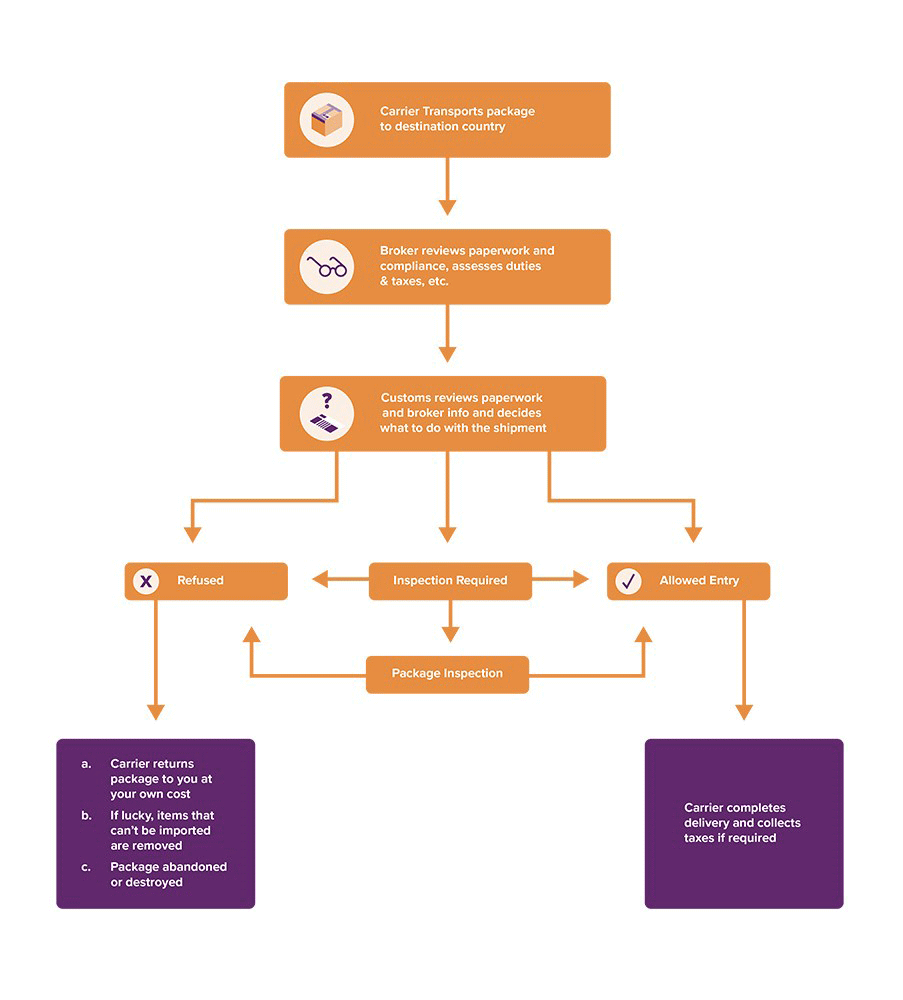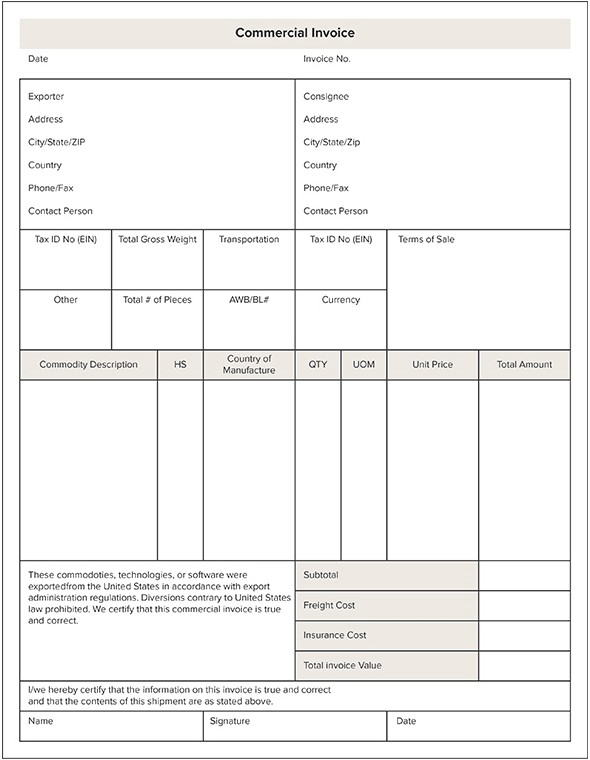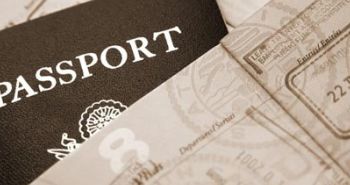If you've made it this far in our learning center, you know we've already covered a wide range of shipping issues: tracking, insurance, cutting costs, and more. One thing we haven't covered is international shipping, which brings some new challenges and regulations. Shipping between countries is generally more restricted than domestic shipping, and you're more likely to encounter unexpected difficulties.
How Shipments Cross Borders
The flow of a package through the border is a point of confusion for a lot of people. So we've created a visual to help explain the process a package undergoes when going to another country.

When a shipment crosses the border, it is first reviewed by a broker at the destination country. They'll look at your paperwork to ensure everything is completed properly and that there are no missing values or any vague information. They will also assess duties and taxes and ensure that your items imported conforms to local laws.
Once this step is complete, the package will now go through customs. Customs officials will review the broker's information and determine whether or not to inspect the package (this could be random in nature or if they suspect you've inaccurately described the contents of your package), refuse the package entry into the country, or let is continue on its route.
Once en route, the carrier completing the delivery is responsible for ensuring that they collect any duties and taxes assessed on the shipment. Depending on the value of the shipment and what prior arrangements you've made with the carrier, package can be held at the depot until payment is arranged with the carrier, or the carrier may attempt to collect payment on delivery. Once that's sorted out, your package is available for delivery.
What documents do I need to ship internationally? International Forms
There are a whole slew of documents that can be required when shipping internationally and it's really going to depend on what item you are shipping, what country the shipment is leaving from and what country your shipment is destined to.
When shipping internationally, you will always need a document called the commercial invoice. There is an exception to this and that is if your shipment contains documents (paperwork) only. In this case a commercial invoice is not required, and generally, no other paperwork.
If you're shipping goods valued at over CAD $2,000 from Canada to any destination except the United States, Puerto Rico, or the US Virgin Islands, you also need to complete and submit a B13a form online.
Commercial Invoice
A commercial invoice is a document completed by you that is used by customs officials to determine:
- If the goods being imported are admissible (ie: Are you allowed to import all the items in your shipment?) and;
- The correct harmonized system (HS) code and rate of duty (ie: How much duty is to be charged on this import?).
While a commercial invoice can vary slightly, you should expect something that looks like this:

Without a complete and correct commercial invoice, your shipment will not be allowed to enter its destination country and would be held at customs until the appropriate information is provided...
If you're unsure of how to fill out a commercial invoice form, check out Shipping 204 of our Learning Center, which focuses on details related to the document.
B13a
If you're shipping goods valued at over CAD $2,000 from Canada to any destination except the United States, Puerto Rico, or the US Virgin Islands, you also need to complete and submit a B13a form online. This also applies to any products that are regulated, controlled, or prohibited. Visit the following link for more information on how to submit the B13a. Without the B13a, your package won't be allowed out of the country, as it's required by Statistics Canada rather than by foreign customs.

We'll dive into the details of the B13a in future lessons.
Other international forms
There are quite a number of other forms such as:
- Certificate of Origin
- FCC 740 (for Electronic Shipments destined to the US)
- FDA 2877 (for devices that emit radio frequencies going to the US)
- Personal Effects (destined to a variety of countries)
- Numerous other international shipping forms
We'll dive into some of these forms in future lessons. If you're not sure what forms you needs, you can always contact a customs broker at the destination country and they can advise you on what documents you'll need to clear customs.
Who is responsible for Duties and Taxes
While the sender is responsible for the costs associated with the shipping itself, taxes and duties aren't applied until the package reaches customs, so by default, they're actually charged to the recipient upon delivery. There are some more details on how to determine the landed costs - duties, taxes, brokerage, etc. - which we'll cover in a later lesson.
Who is responsible for all the paperwork and compliance?
Short answer - The sender. The sender is required to ensure they complete all the necessary paperwork (and that their items shipped) comply with all applicable international treaties, laws, regulations, or requirements of any country to, from, through or over which your shipment may be carried. If it doesn't comply, your shipment could be held at the destination country, the departing country, or sometimes even an intermediate country (ie. a big hub where the shipment transits through before going to the final country) until the necessary compliance is obtained.
You can check some local compliance using UPS' country regulation tool or FedEx' Country Snapshots.
Summary
International shipping comes with a much more strict set of rules and regulations, and it's important to make sure you're in compliance before sending any packages. After all, you don't want that package returned to you or forced to be destroyed after you've paid all that money to get it there.
- Double check local compliance for item and quantity allowance using UPS' country regulation tool
- Ensure you've completed a commercial invoice for any non-document shipments. If you're using Secureship, our system will automatically guide you through this step.
- Be aware that some items shipped may require additional forms. If you don't include them, your item will be held in customs until you can get those forms over to the carrier.
Let's move to Shipping 203, which covers international shipping in a lot more detail.

